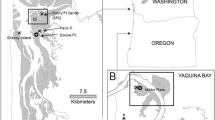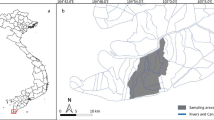Abstract
Extensive shrimp farming around Deep Bay, Hong Kong,began in the mid-1940‘s after the construction of intertidal ponds (gei wai) among the coastal mangroves. The ponds are increasingly being seen as an example of how wetlands can be used sustainablysince they are naturally stocked with shrimp postlarvae (e.g. Metapenaeus ensis) and young fish (e.g. Mugil cephalus) flushed into the ponds from Deep Bay. Once inside, these shrimps and fish feed on naturally occurring detritus on the pond floor. The only gei wai remaining in the Territory, are those at the WWF Hong Kong Mai Po Marshes Nature Reserve, adjacent to Deep Bay. Analysis of the shrimp production between 1990–1995 showed that there were two seasonal peaks, from April–June (Recruitment-I)and from July–October (Recruitment-II). The second peak was significantly lower than the first (p <0.001), especially from those gei wai in the southern part of the reserve which are much closer to a polluted river. The average harvest from each gei wai had also significantly declined from40.9 ±6.0 kg ha−1 yr−1 in 1990 to15.1 ±3.6 kg ha−1 yr−1 in 1995 (p <0.01). This decline can be attributed to the abundance of predatory fish in the gei wai, and increasing water pollution in Deep Bay which adversely affects the amount of shrimp larvae for stocking the gei wai, as well as the quality of water for flushing the ponds during the rearing and harvesting seasons. Despite this, those gei wai which are not-commercially viable can still support many non-commercial, more pollution tolerant fish and shrimp species. As a result, the management of the segei wai has been altered such that their objective is to provide feeding habitat for piscivorous waterbirds, which is also in line with the aims of the nature reserve.
Similar content being viewed by others
References
Apud, F. D., J. H. Primavera & P. L. Torres, 1989. Farming of Prawns and Shrimps. Aquaculture extension manual no. 5. Tigbauan, Philippines.
Allan, G. L. & G. B. Maguire, 1991. Lethal levels of low dissolved oxygen and effects of short term oxygen stress on subsequent growth of juvenile Penaeus monodon. Aquaculture 94: 27–37.
Aquacop, E. Bedier & C. Soyez, 1988. Effects of dissolved oxygen concentration on survival and growth of Penaeus vannameiand Penaeus stylirostris. J. World Aquacult. Soc. 19: 13A.
Bailey, C., 1989. Shrimp mariculture development and coastal resource management: lessons from Asia and Latin America. In Olsen, S. & L. Arriaga (ed.), A sustainable shrimp mariculture industry industry for Ecuador. University of Rhode Island, Rhode Island: 45–70.
Barraclough, S. & A. Finger-Stich. 1996. Some ecological and social implications of commercial shrimp farming in Asia. UNDP/WWF.
Chiu, K. T., 1992. An assessment of the water pollution status of the Mai Po Marshes Nature Reserve, Hong Kong. Ph.D. Thesis, University of Hong Kong, Hong Kong.
Clark, J. V., 1986. Inhibition of moulting in Penaeus semisulcatus (De Haan) by long-term hypoxia. Aquculture 52: 253–254.
Environmental Protection Department, 1995. Marine Water Quality of Hong Kong, 1994. Hong Kong Government Press, Hong Kong.
Fan, H. Q., 1993. Necessity of establishing China Mangrove Research Centre and its task. J. Guangxi Acad. Sci. 9: 122–129.
Imai, T., 1982. Aquaculture in Shallow Seas: Progress in Shallow Sea Culture. Pauls Press, New Delhi: 413–462.
Khor, M., 1995. The aquaculture disaster: third world communities fight the ‘blue revolution’. Third World Resurgence. 5: 8–10.
Kwok, K., 1993. Effects of water level fluctuation of gei waion distribution of waders in the Mai Po Marshes. Unpub. report. City University of Hong Kong.
Le Dien Duc, 1996. Integrated coastal management in the Tien Hai District, Thai Binh Province. Paper presented at the Ecotone IV meeting, Ho Chi Ming City, Vietnam. January 1996.
Lee, S. Y., 1988. The ecology of a traditionally managed tidal shrimp pond, the production and fate of macro-detritus and implications for management. Ph.D. Thesis, University of Hong Kong, Hong Kong.
Liao, I. C., 1992. Diseases of Panaeus monodon in Taiwan: a review from 1977 to 1991. In Fulks, W. & K. L. Main (eds), Diseases of Cultured Penaeid Shrimp in Asia and the United States. The Oceanic Institute, Hawaii: 113–138.
Mackay, R. D., 1974. A note on minimal levels of oxygen required to maintain life in Penaeus schmitti. Proc. Annu. Meet. World Maricult. Soc. 5: 451–452.
Menasveta, P., 1988. Fishery resources. In Arbhabhirama, A. et al. (eds.), Thailand: Natural Resource Profile. Oxford University Press, Singapore: 327–386.
Naamin, N., 1987. Impact of ‘tambak’ aquaculture to the mangrove ecosystem and its adjacent areas with special reference to the north coast of West Java. In Umali, R. M. (ed.), Mangroves of Asia and the Pacific: Status and Management. UNDP/UNESCO Technical Report (RAS/79/002), Quezon City: 355–366.
Pillay, T. V. R., 1993. Aquaculture: Principles and Practices. Blackwell Scientific Publications, Cambridge: 425–459.
Omori, K., T. Hirano & H. Takeoka, 1994. The limitations to organic loading on a bottom of a coastal ecosystem. Mar. Pollut. Bull. 28: 73–80.
Primavera, J. H., 1995. Mangroves and brackishwater pond culture in the Philippines. Hydrobiologia. 295: 303–309.
Shariff, M. & R. P. Subasinghe, 1992. Major diseases of cultured shrimp in Asia: an overview. In Fulks, W. & K. L. Main (eds), Diseases of Cultured Penaeid Shrimp in Asia and the United States. The Oceanic Institute, Hawaii: 37–46.
Shen, Y., 1983. Ecological balance in the Pearl River Delta. Occ. Pap. Dep. Geogr. Chin. Univ. Hong Kong, No 1.
Vanucci, M., 1987. Conversion of mangroves to other uses: The Cochin backwaters. In Umali, R. M. (ed.), Mangroves of Asia and the Pacific: Status and Management. UNDP/UNESCO Technical Report (RAS/79/002), Quezon City: 331–336.
Wong, C. M., 1986. Shrimp farming in Deep Bay–the evolution and present situation of a traditional industry. B.A. thesis, University of Hong Kong, Hong Kong.
Wong, W. L., 1996. The physical and chemical characteristics of the sediment and water in Mai Po Gei wai. B.Sc. thesis, City University of Hong Kong.
Young, L., in Press. Mai Po Marshes, Hong Kong. In Wetlands, Biodiversity and the Ramsar Convention. Ramsar Convention Bureau, Switzerland: 52–53.
Young, L., 1994a. Conservation activities at the Mai Po Marshes Wildlife Education Centre and Nature Reserve. In Higuchi, H. (ed.), The Future of Cranes and Wetlands. Wild Bird Society of Japan, Japan: 166–175.
Young, L., 1994b. Environmental education at the WWF Hong Kong Mai Po Marshes Wildlife Education Centre and Nature Reserve. In Kushler, J. & L. Krantz (eds), Improving Wetland Public Outreach, Training and Education, and Interpretation. The Association of Wetland Managers, New York: 140–148.
Young, L. & D. S. Melville, 1993. Conservation of the Deep Bay environment. In Morton, B. (ed.), The Marine Biology of the South China Seas. University of Hong Kong Press, Hong Kong: 211–232.
Author information
Authors and Affiliations
Rights and permissions
About this article
Cite this article
Cha, M.W., Young, L. & Wong, K.M. The fate of traditional extensive (gei wai) shrimp farming at the Mai Po Marshes Nature Reserve, Hong Kong. Hydrobiologia 352, 295–303 (1997). https://doi.org/10.1023/A:1003064414663
Issue Date:
DOI: https://doi.org/10.1023/A:1003064414663




